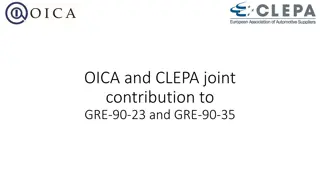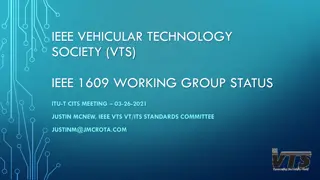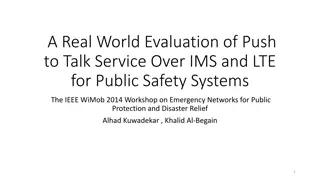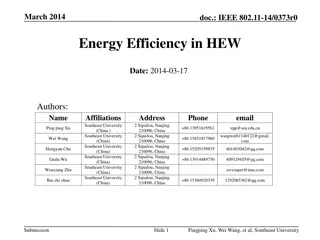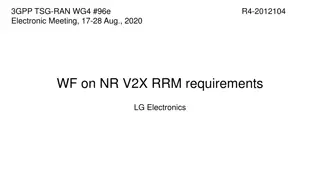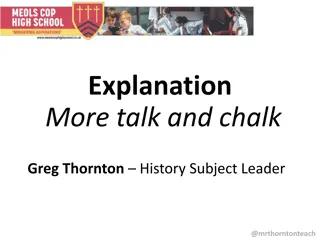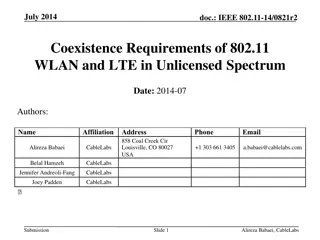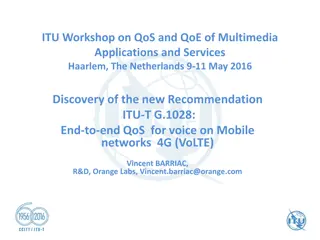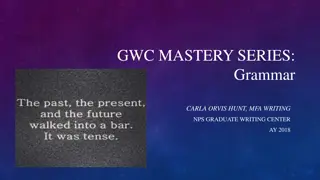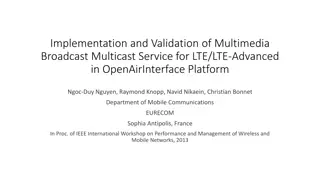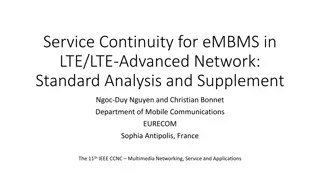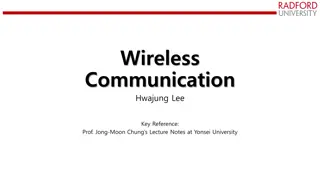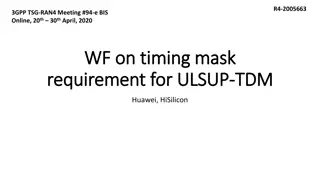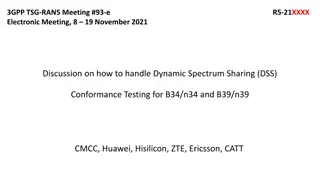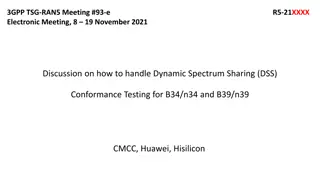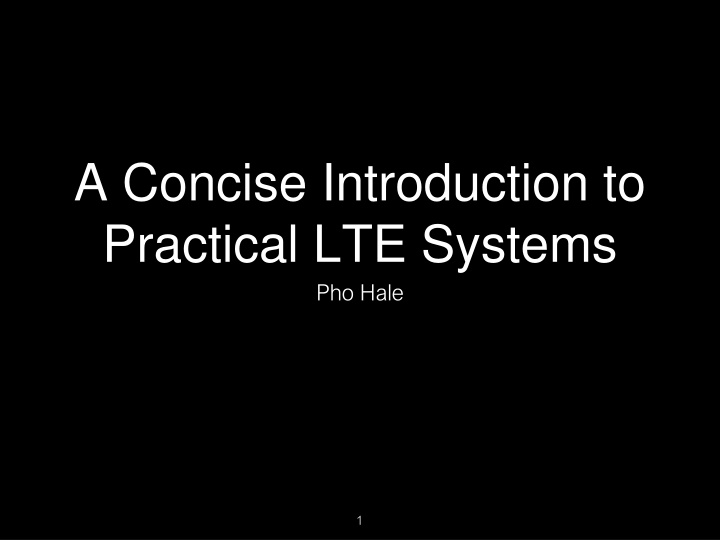
LTE Systems from a Physical Channel Perspective
Explore the physical aspects of LTE systems, from eNodeB communication to synchronization requirements and the impact of multipath fading on signal transmission. Learn about the challenges posed by the physical channel and how it alters transmitted signals in complex wireless environments.
Download Presentation

Please find below an Image/Link to download the presentation.
The content on the website is provided AS IS for your information and personal use only. It may not be sold, licensed, or shared on other websites without obtaining consent from the author. If you encounter any issues during the download, it is possible that the publisher has removed the file from their server.
You are allowed to download the files provided on this website for personal or commercial use, subject to the condition that they are used lawfully. All files are the property of their respective owners.
The content on the website is provided AS IS for your information and personal use only. It may not be sold, licensed, or shared on other websites without obtaining consent from the author.
E N D
Presentation Transcript
A Concise Introduction to Practical LTE Systems Pho Hale 1
Physical Perspective An eNodeB eNodeB communicates through a physical channel a specific UE physical channel with UE. 2
eNodeB To establish a connection to an LTE network, a UE must first determine the following from the eNB base station: Complete time and frequency time and frequency synchronization synchronization information Unique Cell Identity Cell Identity Cyclic Prefix (CP CP) Length Access Mode (FDD FDD/TDD TDD) Synchronization requirements in LTE Symbol Timing Acquisition Carrier Frequency Synchronization Sampling Clock Synchronization 3
Accomplished by broadcasting two special signals: 1. Primary Synchronization Service (PSS PSS): Used for initial synchronization initial synchronization. 2. Secondary Synchronization Service (SSS synchronization. synchronization. SSS): Used for handoff handoff These synchronization signals are transmitted twice per 10ms radio frame. For the sake of simplicity, we will assume from this point that: all parameters necessary for communication between the UE and the radio-access network are known to both entities (RRC_CONNECTED) our UE has successfully established a synchronized connection to our eNB (IN_SYNC). 4
Physical Channel Simply the region between the UE and the eNB. If the physical channel did not alter the signal (i.e. a vacuum) the waveform transmitted would be identical to the waveform received. If the physical channel altered the signal in a predictable and deterministic fashion (i.e. attenuation) the waveform transmitted could be determined exactly by applying an operation on the waveform received. 5
Unfortunately, the physical channel modifies the transmitted signal in a random fashion. The presence of obstacles and reflectors in the communications environment create multiple paths a transmitted signal can traverse. Each copy of a transmitted signal experiences differences in attenuation, delay, and phase shift. This results in either constructive or destructive interference when observed at the receiver. Known as multipath fading multipath fading 6
The multiple copies of a transmitted signal generated by multipath fading arrive at the receiver at different times, inducing and effect known as time dispersion time dispersion. In the frequency domain, time dispersion corresponds to a non- constant channel frequency response. Flat Fading Flat Fading: All frequency components experience the same magnitude of fading. Frequency Frequency- -Selective Fading Selective Fading: Different frequency components experience uncorrelated fading. In LTE, the downlink performance detriments due to frequency-selective fading. downlink (eNB -> UE) uses OFDM OFDM to ameliorate 7
OFDM OFDM divides a wideband signal into tightly packed narrowband subcarriers subcarriers. Each subcarrier is now exposed to flat fading, rather than frequency-selective fading. Two modulated OFDM subcarriers are mutually orthogonal over a given time interval, known as a symbol length, and denoted T_{u}. Unfortunately the delay introduced by multipath fading can shift one subcarrier out of the interval of inter-subcarrier orthogonality, resulting in interference between subcarriers. 8
To solve this interference problem, the duration of each symbol interval is extended by duplicating the last portion of a symbol and adding it as a prefix to the symbol. This is termed cyclic symbol time from T_{u} to T_{u} + T_{cp}. cyclic- -prefix insertion prefix insertion, and it extends the As long as the span of the time dispersion is shorter than T_{cp}, the problem is solved. One last issue: a frequency-selective channel still has the ability to strongly attenuate a given subcarrier. 9
Channel Coding Channel Coding spreads out each bit of information over multiple code bits. These code bits may be distributed in the frequency domain over the entire transmission bandwidth, a process known as frequency interleaving interleaving. frequency This provides frequency diversity frequency diversity to each data bit, ensuring resilience to the failure of any specific subcarrier. 10
User Equipment Concerned with power consumption. Assigned one or more Resource Block (RB) Block (RB) Resource 11
Logical Perspective A Resource Grid Resource Grid represents a 2D data structure over both the time and frequency domain. 12
Time-Domain Resources Variable Symbol Duration Time quantum: Duration (ms) 10 1 0.5 0.5/7 Number of Quanta ( ) 307200 30720 15360 2048 Radio Frame Subframe Slot Symbol 13
Frequency Domain Resources Subcarrier spacing of 15 kHz LTE bandwidth is highly flexible 1 MHz to 20 MHz is standard, even more with carrier aggregation. 14
Algorithmic Perspective Both the receiver and the transmitter implement methods to reduce the detrimental effect of the channel. 16
Adaptive Processing In dynamic rate control dynamic rate control, a transmitter dynamically adjusts the data rate in response to varying channel conditions. The data rate is increased by increasing the channel coding rate and/or modulation scheme when the channel is clear, and decreasing them under disadvantageous conditions. Transmission power is kept constant Also known as Adaptive Modulation and Coding (AMC) Adaptive Modulation and Coding (AMC) Channel conditions can be determined by the receiver by analyzing a transmitted pilot pilot or reference signal reference signal. These results are then reported to the transmitter. 17
Error Correction and Retransmission Forward Error Correction (FEC) Forward Error Correction (FEC) Goal: Introduce redundancy to a transmitted signal to allow bit errors to be corrected by the receiver. These redundant bits, known as parity bits transmitted. parity bits, are computed by applying a coding scheme to the information to be Automatic Repeat reQuest (ARQ) Automatic Repeat reQuest (ARQ) Goal: Introduce redundancy to a transmitted signal to allow bit errors to be detected by the receiver. The receiver validates all received packets: if valid: receiver notifies transmitter with an ACK ACK, data is used if invalid: receiver notifies transmitter with a NAK NAK, data is discarded Hybrid ARQ (HARQ) Hybrid ARQ (HARQ) Uses FEC to correct a subset of all errors, falling back to ARQ for uncorrectable errors. May optionally use soft combining soft combining Packets deemed uncorrectable are stored in a buffer for later use instead of being discarded. 18
DL-SCH CRC Generation 24-bit CRC appended to each transport block (TB Segmentation TB TB is split into smaller code blocks code blocks, each with their own 24-bit CRC. Coding Turbo Coding Turbo Coding is used to encode each code block in parallel. Rate Matching - HARQ each code block is interleaved with a circular buffer the appropriate number of code bits is selected based on cell parameters to be transmitted within a given subframe. Scrambling the block of code bits is XOR ed with a cell-specific scrambling sequence. ensures any potentially interfering signals are randomized, appearing as gaussian white noise to a receiver. Modulation transforms the block of scrambled bits to a corresponding block of complex modulation symbols. TB) 19
References Dahlman, Erik, Stefan Parkvall, Johan Skold, and Per Beming. 3G Evolution: HSPA and LTE for Mobile Broadband. Amsterdam: Academic, 2008. Print. Dahlman, Erik, Stefan Parkvall, and Johan Sk ld. 4G LTE/LTE-Advanced for Mobile Broadband. 2nd ed. Amsterdam: Elsevier/Academic, 2011. Print. Zarrinkoub, Houman. Understanding LTE with MATLAB: From Mathematical Modeling to Simulation and Prototyping. N.p.: Wiley, n.d. Print.


